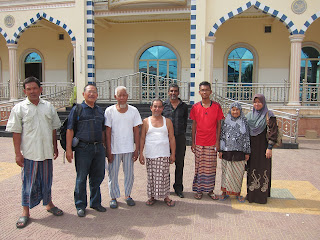It is an inspiring and fascinating story of a towering Malay in a recently published biography of Tan Sri Syed Mokhtar Albukhary (TSSM) written by Premilla Mohanlall and published by pVm communications sdn bhd. What is fascinating is the fact that TSSM was born from a poor family, had only secondary education but inspite of the early handicaps has fought the odds to be one of the richest man in the country. The inspiring things about Tan Sri are many - live simply, always close and guided by his mother, contributes so much to charitable activities, loyal to the people who assisted him, does things with his heart and sharing the fundamentals of success.
TSSM was born 61 years ago last September 2012 in Kedah. At the age of nine he left his family to join his maternal uncle to live in Johor Bahru and had his early education there. He returned to join his parents and continued his secondary school. However he did not sit for his Senior Cambridge examination as he was not able to pay the necessary exam fee. Leaving school he decided to assist his father in the livestock business which prospered initially but the prevalent foot and mouth disease subsequently not only destryed the cattle industry also killed his business. TSSM has his first exposure to business. He embarked in a related business, this time selling meat but this also failed. He decided to take a break and enrolled to do accountancy in an institution in Kuala Lumpur.
He started a transport business and then in rice trade with two Chinese partners and property development. With the implementation of the New Economic Policy after the May 13 incident. TSSM business acumen, coupled with the assistance of a few Government officials, he bidded for many contracts which he succeeded such as food supplies, shoes and uniforms for the armed forces, allocation of shares etc under the various companies that he established. Because of his business success he subsequently became close to the then Prime Minster, YABhg Tun Dr Mahathir Mohamed. He then get involved in a bigger corporate world, first bidding and successfully purchased the Government-linked Company, Malaysian Mining Corporation Bhd and then salvaging an ailing one, Permodalan Nasional (PERNAS) and subsequently the DRB-HICOM. With all these corporations the businesses of TSSM cover plantations, food, oils and gas, property development, banking, education, automobile manufacturing in the country. His business empire has spread its wing to the Middle-East with propery development projects in Saudi Arabia..
His successes were not without challenges. His early livestock and meat trading businesses failed. He lost millions having lost the Bakun and double rail projects as a result of flip-flop decisions of the then Govt, on these projects.
TSSM has paid back his good fortune to the country and the Muslim world and through his Albukhary Foudation he has contributed towards the establishment of education centres; provision of scholarships; helping the old, the infirm, single mothers, the handicapped, orphans and students. He has been identied as one of the top philantropists in the world.
Among his words of wisdom and philosophies of success:
'My mother made many sacrifices for our family. and I will always appreciate that.
She also set a good example as a fine Muslim, something that I try to follow. Till
this day I turn to her for advice, and she never fails me'
'I am not shy when it comes to asking for help from people. I tend to keep in touch
with those who have helped me, and today, some of them are employed by my companies'.
'As a trader it is important not to be just a delivery boy. The govt made it clear, esp
when awarding central contracts to bumiputras. These contracts required us to pack
our products and encouraged us to become involved in manufacturing. I took the
cue, and started to set up factories'.
'The 1985 recession taught me one important lesson: never take anything beyond one's
financial capacity'.
'Whenever I do charity, my heart moves. It is not about corporate social responsibility.
It is about caring, something that comes from the heart. My wish is that people with
money will help those less fortunate so that the world is more just and fair to all'.
'I am a fighter, with strong will to survive. I lost countless nights of sleep, but I did
lose sight of my responsibility to safeguard bumiputra assets and protect the interests
of my staff'.
'My approach is simple. When I want to do something, I do first and talk later'.
'When in the Arab world, your name and reputation is important. It will lead to
people in power. Money comes later. I was comfortable with this'.
'There is this realisation, KEINSAFAN, that I am just another human being who
has been given so much. I thank Allah Subhanah Wataala for His blessings, and
pray I never be caught up by greed'.
'We must always remember the seed we come from, and be humble when blessed
and share good fortune. Otherwise, we are likely to break and fall'.
'The values that have shaped Syed Mokhtar: a respect for hard work and
discipline, compassion for the unfortunate, and an insatiable appetite to
grow and prosper the business'.
'The New Economi Policy (NEP) was created for all races in Malaysia. It is there
for every Malaysian to take advantage of. The NEP is about distributing the nation's
wealth more fairly........Malaysia's richest men today, in some way or other,
trace their wealth to the NEP and political patronage, among them are Robert Kuok,
Ananda Krishnan, Lim Goh Tong, William Cheng, Jeffrey Cheah, Lim Kim Yew,
Yeoh Tiong Lay, Francis Yeoh and Vincent Tan'.

.jpeg)
.jpg)


















